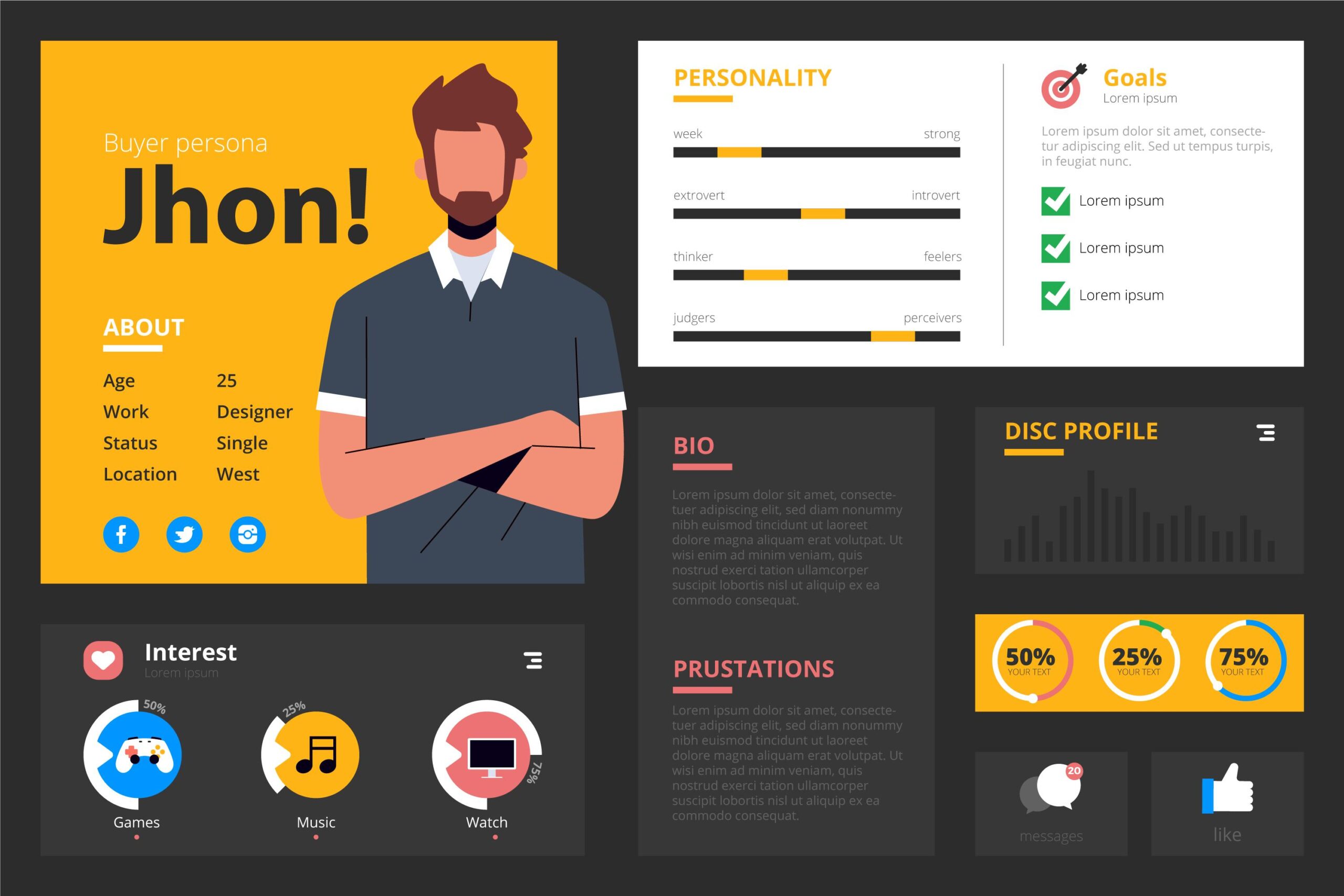In the competitive world of business, brand personas like Nike’s determination, Coca-Cola’s joy, and Airbnb’s community have become essential. More than logos or slogans, these personas embody values and create connections. They’re the reason we choose Nike for resilience, share Coca-Cola for happiness, and trust Airbnb for belonging. In a crowded market, a compelling brand persona isn’t just an identity; it’s a story, an experience. It turns transactions into relationships, making brands unforgettable and cherished.
The Power of Brand Persona: Crafting a Magnetic Brand Identity

In the bustling landscape of the digital age, where brands are vying for attention in the crowded market, there emerges a concept that holds the key to creating a lasting impression: the brand persona. You might wonder, why all the talk about a brand’s persona. What exactly is a brand persona, and why is it so crucial for businesses today? Let’s embark on a journey to demystify this concept and explore its significance in the realm of modern marketing.
What is a Brand Persona?
At its core, a brand persona is the human-like personality that a brand embodies. It goes beyond logos and taglines, delving deep into the emotions, values, and traits that the brand represents. It’s the essence of what the brand stands for, how it behaves, and how it connects with its audience on a personal level. Imagine your brand as a person – what kind of personality traits would it have? Friendly? Professional? Innovative? Trustworthy? These traits collectively form your brand persona.

Why is it Important for Companies to Have a Brand Persona?
A well-defined brand persona acts as a magnet, attracting the right audience and repelling the wrong ones. In a world where consumers are bombarded with choices, a brand persona provides a sense of familiarity and relatability. It builds trust and fosters a sense of loyalty among customers. Moreover, a consistent brand persona creates a unified brand image across all channels, making the brand easily recognizable and memorable.
Where and How Do We Use It?
The beauty of a brand persona lies in its versatility. It seeps into every aspect of the business, shaping marketing strategies, product development, customer service, and even employee behavior. In advertising campaigns, a brand persona helps in crafting compelling narratives that resonate with the target audience. In sales, it guides the approach, enabling sales teams to connect with customers on a personal level. From social media posts to customer interactions, the brand persona is the guiding star that ensures consistency and authenticity in every communication.

How to Create a Brand Persona
Creating a brand persona involves introspection and market research. Understand your audience – their needs, desires, fears, and aspirations. A brand persona serves as the heart and soul of your company, defining its character, values, and the way it interacts with the world. Crafting an authentic brand persona requires careful consideration and creativity. Here’s a step-by-step guide to help you build a compelling brand persona that resonates with your audience and leaves a lasting impression.
Understand Your Audience: To create a brand persona that truly connects, you must first understand your target audience. Conduct market research, surveys, and interviews to gather insights about your customers’ preferences, behaviors, and aspirations. Identify their pain points and what they value in a brand.
Define Your Brand’s Core Values: Determine the fundamental values that your brand represents. Is it innovation, sustainability, authenticity, or something else? These values should align with both your company’s mission and the needs of your audience. Your brand persona should embody and reflect these values in every interaction.
Identify Unique Selling Points (USPs): What sets your brand apart from competitors? Identify your unique selling points – the qualities or features that make your products or services special. Highlight these aspects in your brand persona to emphasize why customers should choose you over others.
Craft Your Brand Personality: Consider your brand as a person. Is it friendly, professional, playful, or serious? Define the personality traits that align with your values and appeal to your audience. Creating a relatable and consistent personality helps in humanizing your brand, making it more approachable.
Develop a Brand Story: Narratives have a powerful impact on human emotions. Develop a compelling brand story that conveys your journey, challenges, and triumphs. Your story should resonate with your audience, evoking empathy and creating a deeper connection. Integrate this story into your brand persona.
Design Visual Elements: Visual elements such as logos, color schemes, typography, and imagery play a significant role in brand perception. Ensure that these elements align with your brand persona and evoke the desired emotions. Consistency across visual elements creates a strong and recognizable brand identity.
Integrate Brand Persona Across Touchpoints: Consistency is key. Ensure that your brand persona is integrated across all customer touchpoints – website, social media profiles, marketing materials, and customer interactions. Consistent messaging and tone of voice enhance brand recognition and trust.
Engage with Your Audience: Actively engage with your audience on social media and other platforms. Respond to comments, participate in conversations, and show genuine interest in your customers. This interaction not only strengthens your brand persona but also builds a community around your brand.
Collect Feedback and Iterate: Listen to your customers. Collect feedback on your brand persona and be willing to iterate. Market preferences change, and your brand persona should evolve with them. Regularly assess the effectiveness of your brand persona and make necessary adjustments.
Measure and Analyze: Use analytics tools to measure the impact of your brand persona on customer engagement, brand loyalty, and sales. Analyze the data to understand what works and what needs improvement. Data-driven insights help you refine your brand persona over time.
Building a compelling brand persona is an ongoing process that requires continuous effort and adaptation. Stay attuned to market trends, listen to your audience, and be open to change. A well-crafted brand persona not only differentiates your business in the market but also forges strong emotional connections with your customers, fostering brand loyalty and advocacy.

Bringing Personas to Life
Nike – Empowering Athletes Worldwide
Background:
Nike, the global sportswear giant, has masterfully crafted a brand persona centered around empowerment, athleticism, and innovation. Their iconic slogan “Just Do It” encapsulates the spirit of determination and resilience.
Brand Persona in Action:
Nike’s brand persona is evident in its marketing campaigns featuring world-class athletes. By associating their brand with athletes like Serena Williams, LeBron James, and Cristiano Ronaldo, Nike communicates a message of empowerment. Their products are not just apparel; they are tools for individuals striving for greatness.
Impact:
Nike’s brand persona has not only led to immense brand loyalty but also inspired millions worldwide. The brand’s commitment to promoting sportsmanship and self-belief has made it a symbol of motivation and achievement.
Coca-Cola – Spreading Happiness and Unity
Background:
Coca-Cola, one of the most recognizable beverage brands globally, has created a brand persona centered around happiness, togetherness, and optimism. Their campaigns often revolve around sharing moments of joy and connection.
Brand Persona in Action:
Coca-Cola’s advertisements frequently depict people from diverse backgrounds coming together and enjoying moments of happiness while sharing a Coke. Through these campaigns, Coca-Cola reinforces the idea that their drink is not just a beverage; it’s a catalyst for creating precious memories and fostering relationships.
Impact:
Coca-Cola’s brand persona has made it more than just a soft drink; it’s a symbol of positivity and unity. The brand’s consistent messaging has contributed to its enduring popularity and a loyal customer base worldwide.
Airbnb – Creating a Sense of Belonging
Background:
Airbnb, the online marketplace for lodging and travel experiences, has built a brand persona focused on community, belonging, and cultural exchange. Their platform connects travelers with local hosts, emphasizing the idea of ‘belonging anywhere.’
Brand Persona in Action:
Airbnb’s brand persona is deeply integrated into its user experience. They encourage hosts to share their unique stories and offer travelers a chance to immerse themselves in local cultures. By facilitating authentic connections, Airbnb goes beyond accommodation; it provides an opportunity for travelers to feel like locals.
Impact:
Airbnb’s brand persona has transformed the travel industry. It has created a community of travelers and hosts who value cultural exchange. Through their platform, Airbnb has redefined travel, making it a means to connect with people and cultures, fostering a sense of belonging wherever one goes.
These case studies showcase diverse approaches to building brand personas, emphasizing the importance of a well-defined and authentic brand identity. Each brand has successfully leveraged its persona to connect with its audience, creating lasting impressions and meaningful relationships.
Embracing the Persona Revolution
In the ever-evolving landscape of marketing, a brand persona acts as the guiding light, leading businesses toward meaningful connections with their audience. It’s not merely a marketing gimmick; it’s the soul of the brand. By understanding, embracing, and embodying a distinctive brand persona, companies can forge lasting relationships, foster brand loyalty, and stand out in the competitive market.
